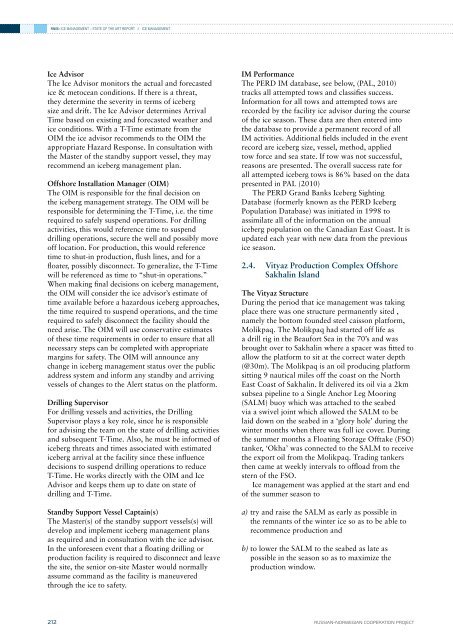phase 4 report - DNV
phase 4 report - DNV
phase 4 report - DNV
You also want an ePaper? Increase the reach of your titles
YUMPU automatically turns print PDFs into web optimized ePapers that Google loves.
RN06: ICE MANAGEMENT – STATE OF THE ART REPORT // Ice ManagementIce AdvisorThe Ice Advisor monitors the actual and forecastedice & metocean conditions. If there is a threat,they determine the severity in terms of icebergsize and drift. The Ice Advisor determines ArrivalTime based on existing and forecasted weather andice conditions. With a T-Time estimate from theOIM the ice advisor recommends to the OIM theappropriate Hazard Response. In consultation withthe Master of the standby support vessel, they mayrecommend an iceberg management plan.Offshore Installation Manager (OIM)The OIM is responsible for the final decision onthe iceberg management strategy. The OIM will beresponsible for determining the T-Time, i.e. the timerequired to safely suspend operations. For drillingactivities, this would reference time to suspenddrilling operations, secure the well and possibly moveoff location. For production, this would referencetime to shut-in production, flush lines, and for afloater, possibly disconnect. To generalize, the T-Timewill be referenced as time to “shut-in operations.”When making final decisions on iceberg management,the OIM will consider the ice advisor’s estimate oftime available before a hazardous iceberg approaches,the time required to suspend operations, and the timerequired to safely disconnect the facility should theneed arise. The OIM will use conservative estimatesof these time requirements in order to ensure that allnecessary steps can be completed with appropriatemargins for safety. The OIM will announce anychange in iceberg management status over the publicaddress system and inform any standby and arrivingvessels of changes to the Alert status on the platform.Drilling SupervisorFor drilling vessels and activities, the DrillingSupervisor plays a key role, since he is responsiblefor advising the team on the state of drilling activitiesand subsequent T-Time. Also, he must be informed oficeberg threats and times associated with estimatediceberg arrival at the facility since these influencedecisions to suspend drilling operations to reduceT-Time. He works directly with the OIM and IceAdvisor and keeps them up to date on state ofdrilling and T-Time.Standby Support Vessel Captain(s)The Master(s) of the standby support vessels(s) willdevelop and implement iceberg management plansas required and in consultation with the ice advisor.In the unforeseen event that a floating drilling orproduction facility is required to disconnect and leavethe site, the senior on-site Master would normallyassume command as the facility is maneuveredthrough the ice to safety.IM PerformanceThe PERD IM database, see below, (PAL, 2010)tracks all attempted tows and classifies success.Information for all tows and attempted tows arerecorded by the facility ice advisor during the courseof the ice season. These data are then entered intothe database to provide a permanent record of allIM activities. Additional fields included in the eventrecord are iceberg size, vessel, method, appliedtow force and sea state. If tow was not successful,reasons are presented. The overall success rate forall attempted iceberg tows is 86% based on the datapresented in PAL (2010)The PERD Grand Banks Iceberg SightingDatabase (formerly known as the PERD IcebergPopulation Database) was initiated in 1998 toassimilate all of the information on the annualiceberg population on the Canadian East Coast. It isupdated each year with new data from the previousice season.2.4. Vityaz Production Complex OffshoreSakhalin IslandThe Vityaz StructureDuring the period that ice management was takingplace there was one structure permanently sited ,namely the bottom founded steel caisson platform,Molikpaq. The Molikpaq had started off life asa drill rig in the Beaufort Sea in the 70’s and wasbrought over to Sakhalin where a spacer was fitted toallow the platform to sit at the correct water depth(@30m). The Molikpaq is an oil producing platformsitting 9 nautical miles off the coast on the NorthEast Coast of Sakhalin. It delivered its oil via a 2kmsubsea pipeline to a Single Anchor Leg Mooring(SALM) buoy which was attached to the seabedvia a swivel joint which allowed the SALM to belaid down on the seabed in a ‘glory hole’ during thewinter months when there was full ice cover. Duringthe summer months a Floating Storage Offtake (FSO)tanker, ‘Okha’ was connected to the SALM to receivethe export oil from the Molikpaq. Trading tankersthen came at weekly intervals to offload from thestern of the FSO.Ice management was applied at the start and endof the summer season toa) try and raise the SALM as early as possible inthe remnants of the winter ice so as to be able torecommence production andb) to lower the SALM to the seabed as late aspossible in the season so as to maximize theproduction window.212RUSSIAN–NORWEGIAN COOPERATION PROJECT






![Risk Based Pipeline Integrity Management [Compatibility Mode] - DNV](https://img.yumpu.com/50424229/1/190x146/risk-based-pipeline-integrity-management-compatibility-mode-dnv.jpg?quality=85)









